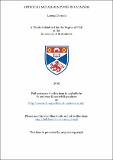Files in this item
Artificial metalloenzymes in catalysis
Item metadata
| dc.contributor.advisor | Kamer, Paul (Paul C. J.) | |
| dc.contributor.author | Obrecht, Lorenz | |
| dc.coverage.spatial | x, 183 p. | en_US |
| dc.date.accessioned | 2015-08-17T09:07:24Z | |
| dc.date.available | 2015-08-17T09:07:24Z | |
| dc.date.issued | 2015 | |
| dc.identifier.uri | https://hdl.handle.net/10023/7248 | |
| dc.description.abstract | This thesis describes the synthesis, characterisation and application of artificial metalloenzymes as catalysts. The focus was on two mutants of SCP-2L (SCP-2L A100C and SCP-2L V83C) both of which possess a hydrophobic tunnel in which apolar substrates can accumulate. The crystal structure of SCP-2L A100C was determined and discussed with a special emphasis on its hydrophobic tunnel. The SCP-2L mutants were covalently modified at their unique cysteine with two different N-ligands (phenanthroline or dipicolylamine based) or three different phosphine ligands (all based on triphenylphosphine) in order to increase their binding capabilities towards metals. The metal binding capabilities of these artificial proteins towards different transition metals was determined. Phenanthroline modified SCP-2L was found to be a promising scaffold for Pd(II)-, Cu(II)-, Ni(II)- and Co(II)-enzymes while dipicolylamine-modified SCP-2L was found to be a promising scaffold for Pd(II)-enzymes. The rhodium binding capacity of two additional phosphine modified protein scaffolds was also investigated. Promising scaffolds for Rh(I)- and Ir(I)-enzymes were identified. Rh-enzymes of the phosphine modified proteins were tested in the aqueous-organic biphasic hydroformylation of linear long chain 1-alkenes and compared to the Rh/TPPTS reference system. Some Rh-enzymes were found to be several orders of magnitude more active than the model system while yielding comparable selectivities. The reason for this remarkable reactivity increase could not be fully elucidated but several potential modes of action could be excluded. Cu-, Co-, and Ni-enzymes of N-ligand modified SCP-2L A100C were tested in the asymmetric Diels-Alder reaction between cyclopentadiene and trans-azachalcone. A promising 29% ee for the exo-product was found for the phenanthroline modified protein in the presence of nickel. Further improvement of these catalyst systems by chemical means (e.g. optimisation of ligand structure) and bio-molecular tools (e.g. optimisation of protein environment) can lead to even more active and (enantio)selective catalysts in the future. | en_US |
| dc.language.iso | en | en_US |
| dc.publisher | University of St Andrews | |
| dc.subject | Artificial metalloenzymes | en_US |
| dc.subject | Artificial enzymes | en_US |
| dc.subject | Catalysis | en_US |
| dc.subject | Enantioselective | en_US |
| dc.subject | Hydroformylation | en_US |
| dc.subject | Diels-Alder | en_US |
| dc.subject | Rh-enzyme | en_US |
| dc.subject | Ni-enzyme | en_US |
| dc.subject | Pd-enzyme | en_US |
| dc.subject | Pt-enzyme | en_US |
| dc.subject | Zn-enzyme | en_US |
| dc.subject | Mn-enzyme | en_US |
| dc.subject | Fe-enzyme | en_US |
| dc.subject | Cu-enzyme | en_US |
| dc.subject | Co-enzyme | en_US |
| dc.subject | Ru-enzyme | en_US |
| dc.subject | Re-enzyme | en_US |
| dc.subject | Ir-enzyme | en_US |
| dc.subject | Aqueous-organic biphasic hydroformylation | en_US |
| dc.subject | Hydroformylation of long chain 1-alkene | en_US |
| dc.subject | Phosphine bearing enzymes | en_US |
| dc.subject | Nitrogen-ligand bearing enzymes | en_US |
| dc.subject.lcc | QP601.7O3 | |
| dc.subject.lcsh | Metalloenzymes | en_US |
| dc.subject.lcsh | Catalysis | en_US |
| dc.subject.lcsh | Enantioselective catalysts | en_US |
| dc.subject.lcsh | Hydroformylation | en_US |
| dc.title | Artificial metalloenzymes in catalysis | en_US |
| dc.type | Thesis | en_US |
| dc.type.qualificationlevel | Doctoral | en_US |
| dc.type.qualificationname | PhD Doctor of Philosophy | en_US |
| dc.publisher.institution | The University of St Andrews | en_US |
This item appears in the following Collection(s)
Items in the St Andrews Research Repository are protected by copyright, with all rights reserved, unless otherwise indicated.

